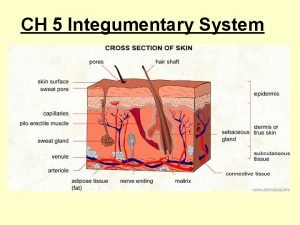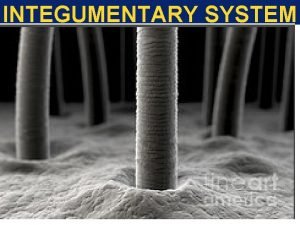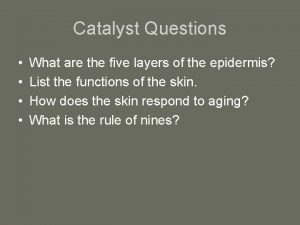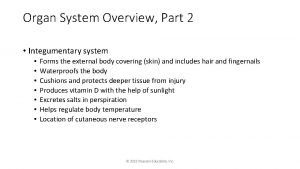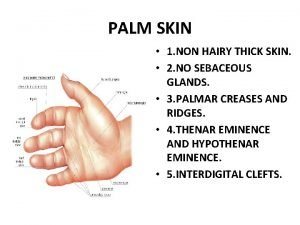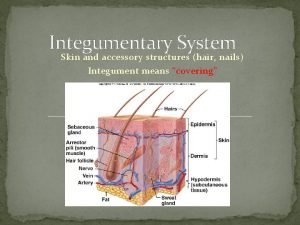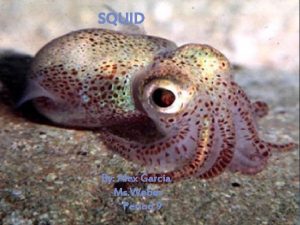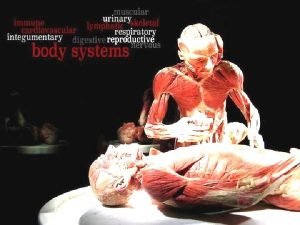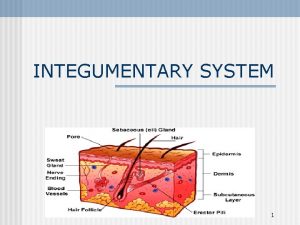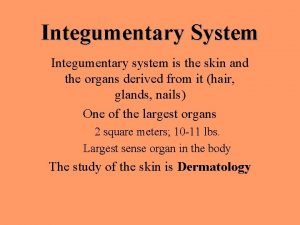The Integumentary System Chapter 5 Integumentary System Structure



































- Slides: 35

The Integumentary System Chapter 5

Integumentary System • Structure – Epidermis – Dermis • Functions of the skin

The “Birthday Suit” • Combination of 4 main tissues – Epithelial – outer layer – Connective – underlies dermis – Smooth Muscle – goose bumps – Nervous – sensory receptors • Structure allows it to carry out many functions – Protection, hydration, sensation, hair to color • Very durable

Functions of the Skin • • Protection Temperature regulation Sensations Storage of chemical compounds Excretion of wastes Synthesis of compounds Determines characteristics

Structure of the Skin • 2 principal parts – Epidermis – Dermis • Beneath the dermis – Hypodermis H u

Epidermis • Stratified squamous epithelium • Avascular • Approximately every month we shed entire skin surface • Consists of keratinocytes H u

Layers of the Epidermis (bottom to top) • Stratum germinativum (stratum basale) – Stem cells • Stratum spinosum – Cells look spiny • Stratum granulosum – Cells die • Stratum lucidum – Found only in thick skin • Stratum corneum – Multiple layers

Variations in Skin Color • Pigments – Melanin • Produced by melanocytes • Protects skin from UV rays – Carotene • Lack of pigment – Albino • Dermal blood supply

Diagnostic Skin Colors • Cyanosis • Albinism – Blueness – Lack of oxygen • Erythema – Redness – Increased blood flow • Pallor – Pale or ashen – Reduced blood flow H u – White – Genetic lack of melanin • Jaundice – Yellow – Liver and bilirubin • Hematoma – Bruise

Epidermis and Dermis • Epidermis is avascular • Dermis is highly vascular • Epidermis receives nourishment from dermis • Cells far away from nourishment die

Dermis • Largest part of the skin • Connective tissue • Contains – Blood vessels – Nerves – Accessory structures • 2 layers – Papillary layer – Reticular layer H u

Papillary Layer • Most superficial layer • Loose connective tissue • Surface area increased by papillae – Form fingerprints Human Anatomy, 3 rd edition Prentice Hall, © 2001

Reticular Layer • Deeper layer • Dense, irregular connective tissue • Contains – Blood vessels – Glands – Deep pressure receptors Human Anatomy, 3 rd edition Prentice Hall, © 2001

Subcutaneous Layer • Loose connective tissue – Packed with adipocytes • Binds dermis to deeper tissue – Stabilizes position of skin • Adipose storage • Aka hypodermis, superficial fascia

Epidermal Derivatives • Hair • Glands • Nails

Hair (Pili) • • Came with mammals Embryological development & distribution Life span of hair What does hair do for mammals?

Functions of Hair • • Protection Thermoregulation Sensory Minor role in humans

Three Types of Hair • Lanugo – fine, downy, unpigmented hair of fetus • Vellus – – • Terminal – Course and pigmented – Eyebrows, eyelashes and scalp – After puberty Fine, unpigmented 2/3 hair of women 1/10 hair of men All of children’s except eyebrows, eyelashes and scalp • • 5 -18 Axillary Pubic Male facial hair Some hair of trunk and limbs

Hair Structure • Shaft – Superficial – Dead tissue • Root – Remainder of hair within follicle – Dead tissue H u

Hair Structure • Medulla – Soft core • Cortex – Hard core • Gives hair stiffness • Cuticle – Outermost layer H u

Hair Develops in Follicles • Diagonal tube extending deep in dermis • Two layers – Epithelial root sheath – Connective tissue root sheath • Bulb contains matrix • Hair papilla – Contains blood vessels and nerves • Associated structures – Hair receptors – Arrector pili

Arrector Pili • • Smooth muscle attaches to follicle Raises hairs Emotional response, cold Function?

Hair Growth and Loss (Scalp) Scalp – 4 to 8 years Eyelashes – 5 months Eyebrows – 2 months 5 -23

• Sebaceous glands Glands – Usually connected to hair follicles – Secrete a waxy, oily substance (sebum) – Develop in utero at about 5 months – Secretion increases at puberty

Glands • Sweat glands – Eccrine glands – Found just about everywhere (esp. palms & soles) – Produce “perspiration” • Water, salt, met. wastes – Merocrine secretion http: //www. pg. com/science/skincare/Skin_tws_35. h

Glands • Sweat glands (scent glands) – Specific type of sweat gland – Found near hair follicles • Axillary & genital regions – Develop at puberty – Called “apocrine” sweat glands • Really merocrine secretion http: //www. pg. com/science/skincare/Skin_tws_35. htm

The Skin with Sweat Glands

Ceruminous Glands • Found in auditory canal • Cerumen – Earwax – Combination of sebum and dead epidermal cells • Keeps eardrum pliable, waterproofs canal, kills bacteria, and coats guard hairs 5 -28

Mammary Glands • • Produce milk during lactation Not synonymous with breasts Small traces in both males and females Modified apocrine gland 5 -29

Nails • • Dorsal surfaces of ends of fingers & toes Primate feature Grasping Derivatives of stratum corneum

Nail Structure • Nail plate – Free edge – Nail body – Nail root • Nail fold • Nail groove • Nail bed – Hyponychium – epidermis – Nail matrix – growth area – Lunule – Eponychium (cuticle)

Skin Cancer • Induced by UV rays (both natural and tanning beds) • Elderly and fair-skinned most common • 3 types – Basal cell carcinoma – Squamous cell carcinoma – Malignant melanoma 5 -32

Basal Cell Carcinoma • Most common • Least dangerous: hardly metastasizes • Arises in stratum basale and invades dermis 5 -33

Squamous Cell Carcinoma • Arises from keratinocytes of stratum spinosum • Can metastasize to lymph nodes • Can be lethal 5 -34

Malignant Melanoma • Most deadly, but only 5% of cases • Arises from melanocyte of existing mole • Metastasizes quickly and often fatal if not treated quickly 5 -35
 Unit 3 integumentary system a&p chapter 5
Unit 3 integumentary system a&p chapter 5 Chapter 6 integumentary system
Chapter 6 integumentary system Chapter 36 skeletal muscular and integumentary systems
Chapter 36 skeletal muscular and integumentary systems Glands in integumentary system
Glands in integumentary system Integumentary system vocabulary
Integumentary system vocabulary Integumentary system of a pig
Integumentary system of a pig Definisi sistem integumen
Definisi sistem integumen Integumentary system facts
Integumentary system facts The integumentary system exercise 7
The integumentary system exercise 7 Integumentary vocabulary
Integumentary vocabulary Integumentary
Integumentary The integumentary system
The integumentary system Integumentary system physical examination
Integumentary system physical examination Integumentary system analogy
Integumentary system analogy The integumentary system
The integumentary system The integumentary system
The integumentary system Integumentary system components
Integumentary system components Integumentary system effects of aging
Integumentary system effects of aging Section 36-3 the integumentary system
Section 36-3 the integumentary system Integumentary system
Integumentary system Integumentary system
Integumentary system Skin homeostatic imbalance
Skin homeostatic imbalance Dermal structure
Dermal structure 6 functions of the integumentary system
6 functions of the integumentary system Anatomy and physiology of psoriasis
Anatomy and physiology of psoriasis Interesting facts about the urinary system
Interesting facts about the urinary system Integumentary system
Integumentary system Large organ of the body
Large organ of the body Integumentary system cpt coding guidelines ppt
Integumentary system cpt coding guidelines ppt Contains several layers of polygonal keratinocytes
Contains several layers of polygonal keratinocytes Aponuerosis
Aponuerosis Integumentary accessory organs
Integumentary accessory organs Integumentary system
Integumentary system Excretory and integumentary system
Excretory and integumentary system Squid integumentary system
Squid integumentary system Body system foldable
Body system foldable











